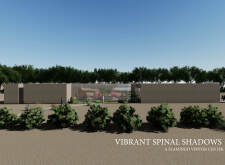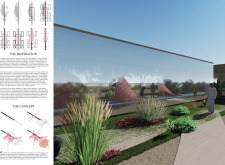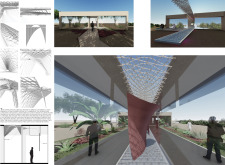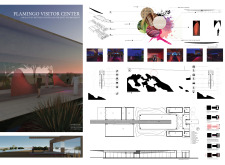5 key facts about this project
At its core, this architectural design serves multiple functions, efficiently catering to the needs of its users while promoting a sense of community and connection with nature. The project may incorporate residential, commercial, or mixed-use spaces, designed to encourage interaction among its occupants. Each area within the structure is purposefully arranged, ensuring a seamless flow from one space to another, which not only enhances usability but also fosters a sense of harmony and well-being.
A keen examination of the project reveals its unique approach to materiality and form. The selection of materials is deliberate, with an emphasis on sustainability and local availability. This may include high-quality concrete, wood, or metal, which not only contribute to the durability of the structure but also harmonize with the surrounding environment. The palette of materials is carefully curated to evoke a sense of warmth and connection, opting for textures and tones that complement the natural landscape.
Moreover, the design embraces innovative architectural ideas that blur the boundaries between indoor and outdoor spaces. Expansive windows and open-air terraces may allow for natural light to flood the interiors, creating a welcoming atmosphere that promotes mental well-being. This connection to the outside world is further enhanced by the incorporation of green roofs or walls, which not only beautify the structure but also contribute to its ecological footprint by promoting biodiversity and improving air quality.
Structural elements within the design may showcase unique geometries, drawing inspiration from both the local culture and the surrounding natural environment. The use of cantilevers, overhangs, and other architectural features not only adds visual interest but also serves practical purposes, such as providing shade and shelter. This attention to detail extends to the building's exterior, which may feature a dynamic façade that responds to the changing light throughout the day, enhancing its visual appeal.
Another notable aspect of this project is its integration of technology and smart design principles. Incorporating energy-efficient systems and smart home capabilities signifies a forward-thinking approach, emphasizing the importance of sustainability in modern architecture. This focus on technological integration helps to create spaces that are not only functional but also adaptive to the needs of their inhabitants.
The project embodies a holistic approach to architecture, considering both the immediate context and the broader implications of its design choices. It addresses pressing societal needs such as housing, communal space, and environmental responsibility, making it a relevant project in today's architectural discourse. The emphasis on community engagement and interaction resonates deeply with contemporary architectural philosophies that prioritize user experience and environmental stewardship.
This architectural endeavor invites onlookers and enthusiasts alike to delve deeper into its components. For those interested in understanding the intricate details that underpin this project, exploring architectural plans, sections, and design elements is highly recommended. Engaging with these resources provides valuable insight into the thoughtful processes that shaped this project, allowing for a fuller appreciation of its design outcomes and architectural significance. By examining architectural ideas and how they materialize in practice, one can better understand the profound impact that well-considered architecture has on our environments and communities.


























